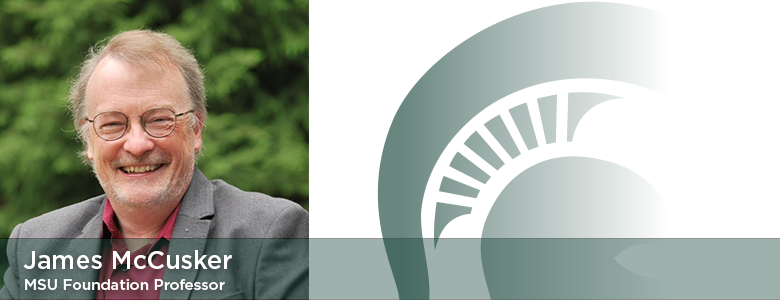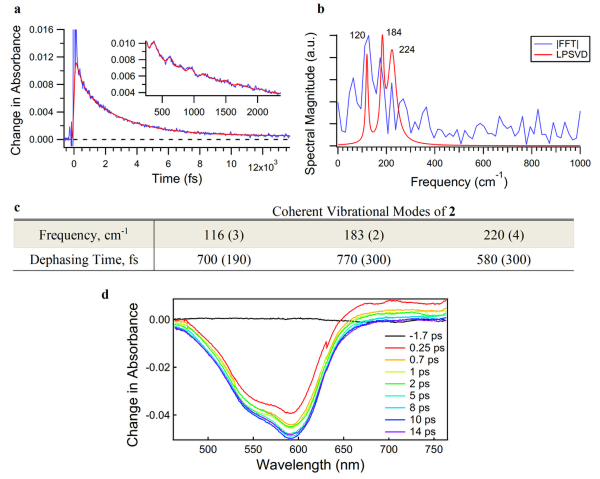James McCusker

Research
Synthesis and Spectroscopy of Transition Metal Complexes
(Research Description PDF)
The McCusker Group is interested in the physical and photophysical properties of transition metal complexes. Our approach relies on a confluence of synthetic chemistry, a host of physical techniques ranging from magnetism to femtosecond time-resolved spectroscopy, and high-level theory. The simultaneous examination of chemical problems on all three of these fronts places us in a unique position to explore the physical chemistry of inorganic compounds.
Ultrafast Spectroscopy of Transition Metal Complexes. Our research efforts in this area concern the short time scale photo-induced dynamics of transition metal complexes. By “short time scale”, we refer to processes occurring between the time a photon is absorbed by a molecule and the point at which that molecule is fully relaxed in its lowest-lying excited state. Some of the questions we are addressing with this research include the following: 1) what is the general time scale for excited-state evolution in transition metal complexes? 2) what is the mechanism of this process? 3) how do the geometric and electronic structures of the compounds, the surrounding medium, and other factors couple to and/or influence this process? and 4) to what extent can we use this information to control excited-state dynamics? Certain of these questions are very fundamental in nature, whereas others are geared toward work on solar energy conversion. What distinguishes the group, we believe, is our ability to carry out both the synthesis and spectroscopic characterization of a wide range of inorganic molecules. This enables us to systematically examine chemical perturbations to excited-state electronic and geometric structure, and in so doing develop a comprehensive picture of how transition metal chromophores absorb and dissipate energy.
Spin and Spin Polarization Effects on Excitedstate Dynamics. Electron spin is a fundamental property of Nature. Although many of the more common
physical observables linked to spin are well documented (e.g., magnetism), the degree
to which spin and spin polarization influences the chemistry of molecular systems
is not as clear. We are pursuing the design and development of chemical systems that
will allow us to determine whether there exists a cause-and-effect relationship between
the physical and photophysical properties of molecules and their innate spin properties,
and if so, to what extent can we exploit this connection in order to manipulate the
chemistry of molecular systems. Much of this work centers on the study of so-called
donor-acceptor assemblies wherein energy and electron transfer processes are being
examined in systems containing spin-coupled paramagnetic fragments. Through careful
synthetic manipulation of these compounds, correlations between the observed excitedstate
reactivity and the involvement of spin-polarized electronic states of the donor
and/or acceptor can be realized. Coupled to this experimental work are theoretical
studies that exploit recent advances in density functional theory. We believe that
these combined efforts will forge an important link between magnetisn and electron/energy
transfer processes, thereby allowing us to establish a new paradigm in the emerging
field of molecular spintronics.
Contact / Webpage
Area(s) of Interest
Inorganic (In)
Material (Ma)
Physical (Ph)
Selected Publications
Leveraging Excited-state Coherence for Synthetic Control of Ultrafast Dynamics, B.C. Paulus, S.L. Adelman, L.L. Jamula, and J.K. McCusker, Nature 2020, in press.
Outer-sphere Effects on the Ligand-field Excited-state Dynamics: Solvent Dependence of High-spin to Low-spin Conversion in [Fe(bpy)3]2+, J.N. Miller and J.K. McCusker, Chem. Sci. 2020, 11, 5191 - 5204.
The Influence of Electrolyte Composition on Ultrafast Interfacial Electron Transfer in Fe-sensitized TiO2-based Solar Cells, C.R. Tichnell, J.N. Miller, C. Liu, S. Mukherjee, E. Jakubikova, and J.K. McCusker, J. Phys. Chem. C 2020, 124, 1794 - 1811.
Electronic Structure in the Transition-metal Block and its Implications for Light Harvesting, J.K. McCusker, Science 2019, 363, 484-488.
Insights into the Excited-state Dynamics of Fe(II) Polypyridyl Complexes fromVariable-temperature Ultrafast Spectroscopy, M.C. Carey, S.L. Adelman, and J.K. McCusker, Chem. Sci. 2019, 10, 134-144.
Utilizing Coherence to Enhance Function in Chemical and Biophysical Systems, G.D. Scholes, G.R. Fleming, L.X. Chen, J.K. McCusker, et al., Nature 2017, 543, 647-656.
Photosensitized, Energy Transfer-mediated Organometallic Catalysis through Electronically Excited Ni(II), E.R. Welin, C. Le, D.M. Arias-Rotondo, J.K. McCusker, and D.W.C. MacMillan, Science 2017, 355, 380–385.
The Photophysics of Photoredox Catalysis: A Roadmap for Catalyst Design, D.M. Arias-Rotondo and J.K. McCusker, Chem. Soc. Rev. 2016, 45, 5803–5820 (cover article).
CV
B.S. and M.S., 1987, Bucknell Univ.
Ph.D., 1992, Univ. of Illinois at Urbana Champaign
NIH Post-Doctoral Fellow, 1992-94, Univ. of North Carolina at Chapel Hill
Hellman Faculty Fellow, 1997-98, Univ. of California at Berkeley
Alfred P. Sloan Fellow, 1998-2000
Awards
| Year | Award | Organization |
|---|---|---|
| 2020 | Royal Society of Chemistry Honor | |
| 2018 | Foundation Professor | Michigan State University |
| 2016 | Fellow of Royal Society of Chemistry | Royal Society of Chemistry |
| 2016 | Outstanding Faculty Award | Michigan State University (College of Natural Science) |
| 2013 | CNS Junior Faculty Mentoring Award | |
| 2011 | Councilor to the American Chemical Society by the Division of Inorganic Chemistry | |
| 2005 | Program Committee | International Conference on Bio-Inorganic Chemistry |
| 2004 | Awards Committee | Inter-American Photochemical Society |
| 2003 | Organizer | American Chemical Society (National Meeting - From Mixed-Valency to Single-Molecule Magnets: A Symposium in Honor of the Work of David N. Hendrickson) |
| 2003 | NSF Career Award panelist (Inorganic, Bioinorganic, and Organometallic Chemistry subdivision) | National Science Foundation |
| 2003 | Organizing Committee Member | 14th Inter-American Photochemical Society Winter Meeting |
| 2002 - 2003 | Nominations and Symposia Planning Committee, Division of Inorganic Chemistry | American Chemical Society |
| 1999 | Department of Chemistry Teaching Award | University of California, Berkeley |
| 1998 - 2000 | Alfred P. Sloan Fellowship | Alfred P. Sloan Foundation |
| 1997 - 1998 | Hellman Fellow | University of California, Berkeley |
| 1992 - 1994 | Postdoctoral Fellow | National Institutes of Health |
| 1992 - 1994 | Postdoctoral Fellow | National Institutes of Health |
| 1992 | Ph.D. | University of Illinois, Urbana-Champaign |
| 1987 | Phi Beta Kappa | Phi Beta Kappa |
| 1987 | M.S. | Bucknell University |
| 1987 | Bachelor of Science | Bucknell University |
| 1987 | cum laude | Bucknell University |
| 1987 - 1988 | Graduate Fellowship | University of Illinois, Urbana-Champaign |
| 1987 | Outstanding Senior Chemistry Major of the Year | American Chemical Society ((Susquehanna Valley Section) and the Faculty of Bucknell University) |
| 1987 | Honorable Mention | National Science Foundation Graduate Fellowship Competition |
| 1985 | Phi Eta Sigma | Phi Eta Sigma |